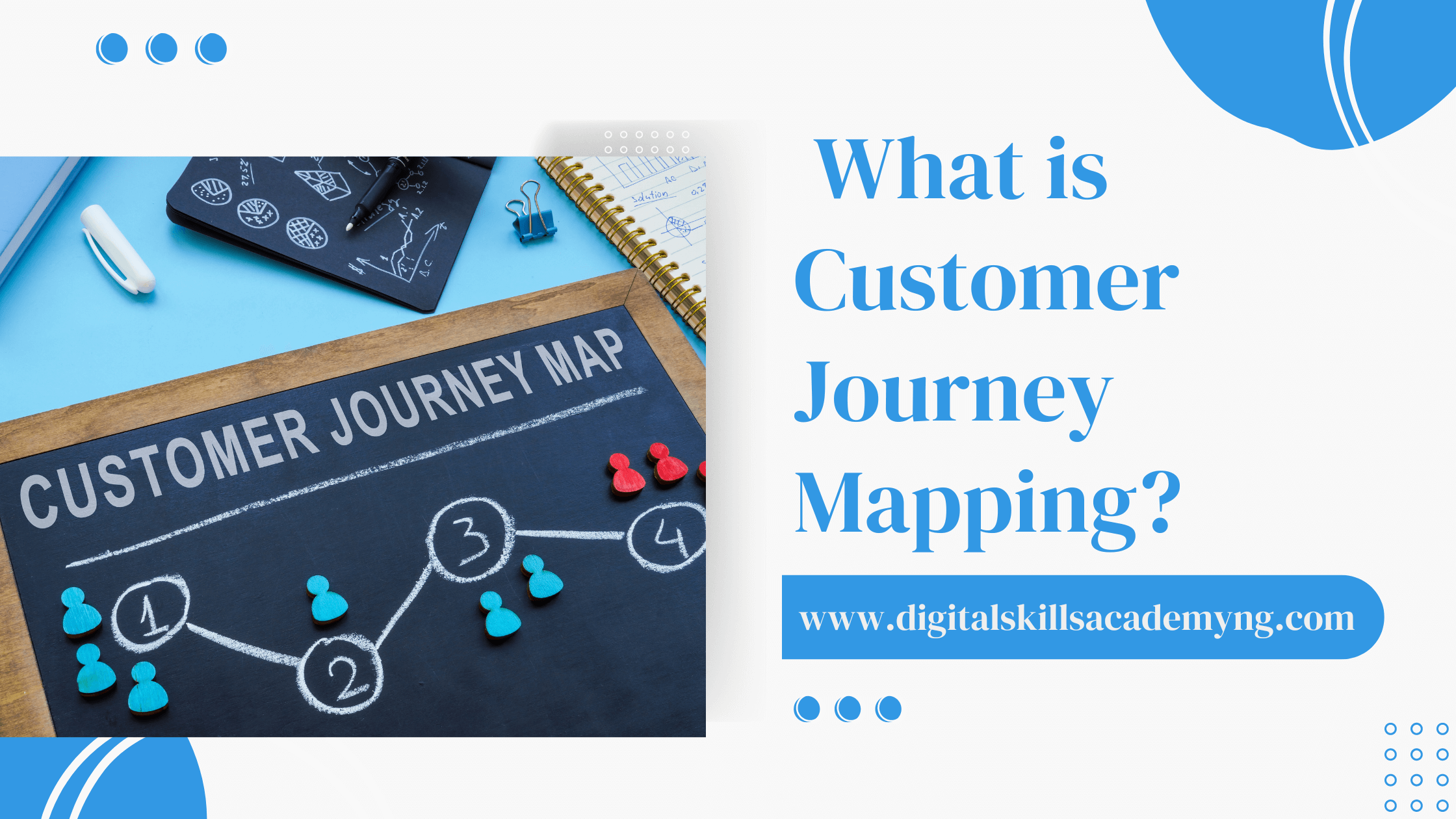What is Customer Journey Mapping?
Table of Contents
Customer journey mapping is a strategic approach that visualizes the process customers go through when interacting with a brand, product, or service. It provides an end-to-end view of the customer experience, highlighting every touchpoint, emotion, and decision a customer encounters.
The map can cover the entire lifecycle of a customer’s relationship with a brand, from the initial awareness stage to post-purchase interaction.
A customer journey map often includes;
Touchpoints: These are the interactions between the customer and the brand, which can happen across various channels like websites, social media, emails, physical stores, etc.
- Customer Actions: What the customer does at each stage, such as searching for information, purchasing, or seeking customer service.
- Emotions: Understanding the customer’s feelings at each stage helps identify pain points and moments of delight.
- Channels: Where the interactions occur—online, in-store, over the phone, etc.
- Pain Points: Issues that frustrate or cause problems for the customer.
Benefits of Customer Journey Mapping
- Enhanced Customer Experience
Businesses can enhance overall customer satisfaction by understanding and improving every step of the customer’s journey. Identifying pain points allows companies to take corrective action, ensuring a smoother and more enjoyable experience.
- Improved Customer Retention
When customers have a positive experience with a brand, they are more likely to return. A well-crafted customer journey map helps customers remain engaged and loyal over the long term.
- Alignment across Departments
Customer journey mapping fosters collaboration across marketing, sales, and customer service departments. By working together on a shared understanding of the customer experience, these departments can ensure a consistent and seamless experience.
- Increased Revenue
Companies can increase conversion rates and lifetime value by optimizing the customer journey. Satisfied customers are likelier to repeat purchases and recommend the brand to others.
- Better Understanding of Customer Needs
Mapping the customer journey provides deep insights into customer behavior, preferences, and needs. This knowledge helps in creating more targeted and effective marketing strategies.
Stages of Customer Journey Mapping
Creating a customer journey map typically involves several stages, each crucial for understanding the customer experience comprehensively.
- Research and Data Collection
Start by gathering data from various sources such as customer interviews, surveys, analytics, and customer feedback. This stage is critical for understanding who your customers are, what they need, and how they interact with your brand.
- Identify Customer Personas
Customer personas are fictional representations of your ideal customers based on accurate data. Each persona should include demographic information, goals, pain points, and behavior patterns. Defining customer personas helps you understand different segments of your audience and how they might experience the journey differently.
- Define Touchpoints
Touchpoints are all the interactions a customer has with your brand. These can occur across multiple channels, such as your website, social media, email, or physical store. Identifying these touchpoints is critical to mapping out the customer journey.
- Map the Current Journey
Using the data collected, create a visual representation of the customer journey. This map should include all the stages, touchpoints, customer actions, emotions, and channels. Highlight areas where the experience is vital and where improvements are needed.
- Identify Pain Points and Opportunities
Analyze the current journey map to identify areas where customers may be experiencing frustration or obstacles. Look for opportunities to improve the experience, such as streamlining processes, providing additional support, or personalizing communication.
- Design the Future Journey
Based on the insights gathered, design an ideal customer journey that addresses the pain points and enhances the overall experience. This future journey map should outline the changes needed to achieve the desired customer experience.
- Implement and Monitor Changes
Once the future journey map is created, it’s time to implement the necessary changes. This may involve updating processes, training staff, or integrating new technologies. After implementation, continuously monitor the customer experience to ensure that the changes are effective.
How to Create a Customer Journey Map
Creating a customer journey map is a detailed process that requires careful planning, research, and collaboration across departments.
Here’s a step-by-step guide;
Step 1: Define Your Objectives
Before starting the mapping process, it’s essential to define the objectives of your customer journey map. What do you want to achieve? Are you looking to improve customer satisfaction, reduce churn, or increase conversions? Clear objectives will guide the entire mapping process.
Step 2: Gather Data and Insights
Collect data from various sources to gain a comprehensive understanding of your customers. This data may include:
- Customer Interviews and Surveys: Customer feedback provides valuable insights into their experiences and expectations.
- Analytics Website analytics, social media metrics, and CRM data help track customer behavior and identify trends.
- Customer Feedback Reviews, ratings, and comments can reveal common pain points and areas for improvement.
Step 3: Create Customer Personas
Based on the data collected, create detailed customer personas. Each persona should include:
- Demographics: Age, gender, income, education, etc.
- Goals and Motivations: What are they trying to achieve?
- Pain Points: What are the challenges or frustrations they face?
- Behavior Patterns: How do they interact with your brand?
Step 4: Identify Customer Touchpoints
List all the touchpoints where customers interact with your brand. These could include:
- Online Touchpoints Website, social media, email, etc.
- Offline Touchpoints Physical stores, customer service calls, events, etc.
Step 5: Map the Current Journey
Create a visual map of the customer journey using the information gathered. Include all the stages, touchpoints, customer actions, and emotions. This map should provide a clear picture of today’s customer experience.
Step 6: Analyze and Identify Gaps
Examine the current journey map to identify any gaps or pain points. Look for areas where the experience could be improved, such as long wait times, confusing processes, or lack of personalized communication.
Step 7: Design the Future Journey
Based on your analysis, design a future customer journey that addresses the identified gaps. This map should outline the changes needed to enhance the experience, such as:
- Optimizing Touchpoints, Streamlining processes, improving website navigation, etc.
- Personalizing Communication Tailoring messages to individual customer needs.
- Enhancing Support by Providing additional resources or training for customer service teams.
Step 8: Implement the Changes
Once the future journey map is designed, work with relevant departments to implement the necessary changes. This may involve updating technology, retraining staff, or revising processes.
Step 9: Monitor and Optimize
After implementing the changes, continuously monitor the customer experience to ensure the new journey delivers the desired results. Use customer feedback, analytics, and other metrics to track progress and make further improvements.
Customer Journey Map Template
Creating a customer journey map from scratch can be a complex task. A template can simplify the process and ensure all critical elements are included.
Below is a simple template that you can use as a starting point:
- Customer Persona
Name (Name of the persona)
Demographics (Age, gender, income, etc.)
Goals (What they want to achieve)
Pain Points (Challenges they face)
- Stages of the Journey
Stage 1 Awareness (How the customer becomes aware of the brand)
Stage 2 Consideration (How the customer evaluates the brand)
Stage 3 Decision (How the customer decides to purchase)
Stage 4 Purchase (The actual purchase process)
Stage 5 Post Purchase (Follow-up interactions, support, etc.)
- Touchpoints
Online Touchpoints Website, social media, email, etc.
Offline Touchpoints, Physical stores, customer service calls, etc.
- Customer Actions
Actions at Each Stage: What the customer does at each stage (e.g., searching for information, making a purchase)
- Emotions
Emotions at Each Stage: How the customer feels at each stage (e.g., excited, frustrated)
- Pain Points
Pain Points at Each Stage Challenges or frustrations the customer faces at each stage.
- Opportunities
Opportunities at Each Stage Areas where the experience can be improved.
Examples of Customer Journey Mapping
To better understand how customer journey mapping works in practice, let’s look at a few examples across different industries:
Example 1: Ecommerce
Customer Persona: Sarah is a 30-year-old working professional looking for skincare products.
Journey Stages:
Awareness: Sarah sees an ad for skincare products on social media.
Consideration: She visits the website to explore the product range.
Decision: After reading reviews and comparing products, she adds items to her cart.
Purchase: She completes the purchase and receives a confirmation email.
Post Purchase: Sarah receives follow-up emails with tips on how to use the products.
Pain Points.
- Difficulty navigating the website.
- Uncertainty about product effectiveness.
Opportunities.
- Simplify website navigation.
- Provide more detailed product descriptions and reviews.
Example 2: Retail Store
Customer Persona: Emily is a 25-year-old fashion enthusiast looking for a new outfit.
Journey Stages:
Awareness: Emily sees an Instagram post featuring a new clothing collection.
Consideration: She visits the store to try on the clothes.
Decision: After trying on several outfits, she decides to purchase.
Purchase: Emily buys the clothes and receives loyalty points.
Post Purchase: She receives a thank you email with personalized recommendations.
Pain Points.
- Limited availability of sizes in the store.
- Long wait times at the checkout.
Opportunities.
- Improve stock management to ensure availability.
- Streamline the checkout process to reduce wait times.
How to Increase sales for your brand
What We Say
Customer journey mapping is a powerful tool that allows businesses to step into their customers’ shoes and understand their experiences from start to finish. By identifying touchpoints, emotions, pain points, and opportunities, companies can create a more seamless and satisfying customer experience.
Whether in ecommerce, retail, or any other industry, investing time in customer journey mapping can increase customer satisfaction, loyalty, and revenue. With a well-executed customer journey map, you’ll be well on your way to delivering exceptional experiences that keep customers returning.




